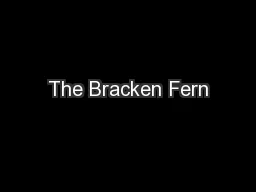

Pteridium aquilinum Toxic effects on surrounding organisms and environment By Peter Andriakos General Information Wide distribution Globally extensive Widest distribution of any fern genus ID: 228558
Download Presentation The PPT/PDF document "The Bracken Fern" is the property of its rightful owner. Permission is granted to download and print the materials on this web site for personal, non-commercial use only, and to display it on your personal computer provided you do not modify the materials and that you retain all copyright notices contained in the materials. By downloading content from our website, you accept the terms of this agreement.
Slide1
The Bracken Fern (Pteridium aquilinum)
Toxic effects on surrounding organisms and environment
By: Peter
AndriakosSlide2
General InformationWide distributionGlobally extensiveWidest distribution of any fern genusAmong most common plants on the planet
Locally intensive
Rapid invasion of de-forested areas
Cover increasing at a global level
Major problems in the UK, Scotland, Wales, South America
Slide3
General Info. (cont.)Persistence spreads via rhizome widespread underground rootstock forms expansive stands, dense thickets Resilience
limited only by extreme cold, altitude observed growing in wide range of soil pH
highly successful dispersal abilities Slide4
Human Bracken Fern Consumption
Bracken fiddleheads harvested
Many cultures throughout history
Maori (NZ)
herbal remedy, food
Eastern Asia (Japan, China, Korea)
staple vegetable
Still utilized today as a foodstuff
Toxic effects are now known
continues to be utilizedSlide5
Non- Human Consumption Animal consumption Domestic HerbivoresRestricted feed availabilityWill consume readily Major problem
Toxic effects on animalsIndirect effects on humans
Toxic effects observed in all animal species known to consume
Pteridium
aquilinum
Cows consuming
Pteridium
aquilinum
while grazingSlide6
Toxic and Carcinogenic Effects of Bracken Fern Wide variety of toxic effects observed vary by species among other factors Several known toxins isolated from Bracken several carcinogenic others mutagenic
Experimental determination of toxicity
studies conducted with laboratory animals
myriad of syndromes observed
again, vary by species Slide7
Bracken carcinogens in the human diet(Mahmood Shahin, Barry L. Smith, Arungundrum S. Prakash) An all encompassing article… Bracken Fern issues seen in animals
Human health risks Primary carcinogenic principal Mode of carcinogenic action
Cancer modelSlide8
Toxic syndromes in animals Numerous acute, toxic syndromes observedinduced thiamine deficiency acute hemorrhagic syndrome Severity dependant on… species and age of animal quantity/quality of plant consumed
consumption rateSlide9
Acute hemorrhagic syndrome seen in ruminants degenerative change in more rapidly dividing cells epithelial necrosis - larnyx, pharynx, small intestine bone marrow
aplasia -Platelet production ceases -“Hemorrhagic crisis” occurs -Leucopenia, thrombocytopenia, granulocytopenia
Death occurs in a matter of weeksSlide10
Chronic Toxic SyndromesChronic toxicity in animals also observed… Bright blindness seen in sheep (ruminant) (Watson et al., 1965) retinal stenosis, atrophy (Watson et al.,1972) Enzootic hematuria
Tumors in the bladder mucosa hemorrhaging in bladder wallPamukcu et al., 1967
Carcinomas
upper digestive tractSlide11
Laboratory Animal Experimentation Rats first report of carcinogenic potential (Evans, Mason. 1965) Diets containing Bracken powder, fronds, rhizomesHigher incidence of tumor formation vs. control Fronds vs. rhizomes (Hirono
et al.,1973) Duration of exposure critical factor
Subjects fed 33% dried bracken (
Hirono
et al., 1970)
4 months vs. 8 monthsSlide12
Mice feeding trials, dried bracken (Yasuda et al.,1974) rib anomalies, sternebrae fusionTumor formation Carcinogenic effects of cow milk (Pamukcu et al., 1978)Other experimental animals…Guinea Pigs
Japanese QuailEgyptian ToadsSlide13
Human Health RisksIndirect effects of animal consumption milk obtained from bracken fed cattle leaching in to water supply aerial dispersion of spores Esophageal carcinomas observed
Japan (Kamon et al., 1975) Gastric cancer frequency
Wales (
Galpin
et al., 1990)
Costa Rica (Villalobos-Salazar et al., 1989) Brazil (Marliere et al., 1995) Slide14
Toxic Compounds Numerous molecules isolatedCarcinogenic, mutagenicQuercetin mutagenPtaquiloside (PT) 10 carcinogenic principle
Ptaquiloside
molecule
Quercetin
moleculeSlide15
Ptaquiloside (PT)Principal carcinogen in BrackenNorsesquiterpene glucosideDifficult to isolate Carcinogenicity confirmed by Hirono et al. in 1984Various other experimental confirmationsSlide16
PT Action MechanismProposed scheme of PT reaction pathwaySlide17
Carcinogenic basis of PTCarcinogenesis initial DNA damage DNA alkylation (adenine, guanine)
Adenine
Guanine
DNA StructureSlide18
PT Cancer ModelMultistage model for bracken-induced carcinogenesisSlide19
Occurrence of the carcinogenic Bracken constituent ptaquiloside in fronds, topsoils, and organic soil layers in Denmark(Rasmussen, Kroghsbo, Frisvad, Hansen) relevance human uptake via watersheds
Investigate occurrence of PT in fronds, topsoil materials
Multivariate data analysisSlide20
Materials/Methods20 populations chosen in Denmark3 sub-sites at each locationSample at end of growing seasonSoil + plant materialDried milled stored @ 4
0 C
Frond height and density measured
Map of Denmark, study sites indicatedSlide21
Soil Horizonshttp://www.dpi.vic.gov.au/CA25677D007DC87D/LUbyDesc/AG1060a/$File/AG1060a.gifSoil Horizon Diagram
Focus was on topsoil layersHorizons O and A
1
Slide22
Other measurements takenSoil pHOrganic Carbon ContentBracken BiomassPrecipitation levelLight exposureTurnover rate
Partial Least Square Regression Analysis (PLSR)
Performed on all variables less PT content
Correlate parameters with PT content in fronds, horizons
PT analysis
Fronds, litter,
O/A horizons Extraction using de-ionized H
2
0
“cleaning" of sample with a resin
Conversion to pterosin B
Liquid chromatograph utilizedSlide23
ResultsPtaquiloside content PT content in… Fronds 110 - 3800 [μg g
-1 ], mean = 550 [μg
g
-1
]
O horizons 0.09 - 6.43 [μg g
-1 ], mean = 0.39 [μ
g
g
-1
]
A horizons 0.011 – 0.713 [
μ
g
g
-1
], mean = 0.031 [
μ
g
g
-1
]
Slide24
Results PLSR findings(+)(-)Light exposure
Frond heightTurnover Rate
Carbon Content
Fronds
(+)
(-)
Precipitation
Amt.
of Litter
Turnover
Rate
Stand Size
O horizons
(+)
(-)
Soil
pH
Precipitation
Stand
Size
Easting
A horizonsSlide25
Conclusions Definitive evidence that PT is found in topsoils beneath Bracken standsPossibility that leaching does occurHigh precipitation areas most susceptible to watershed contaminationSlide26
Questions RaisedHow concerned should a local human population be?Should Bracken management be implemented?Has been in some areas…Do these strategies need to be re-evaluated for their efficacy?Bracken cover is increasing rapidly… Need to think about Bracken management in agriculture from an environmental point of view…